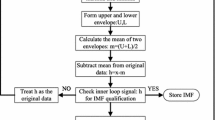Abstract
We hereby propose an Empirical Mode Decomposition (EMD) method improved with a multi-scale median filtering for extraction of the time–frequency feature of telemetry vibration signals under interference from impulse noise. The signal is decomposed into a series of intrinsic mode functions (IMF) by EMD roughly. Median filtering is then performed on each IMF with filter window length varying with the IMF’s frequency, respectively. This maneuver will allow effective impulse noise suppression with minimal loss of signal integrity. A new signal can then be reconstructed by adding up each component after the median filtering and treated with a repeat EMD to obtain new IMFs as a final result. This method overcomes the filtering window length selection problem in the median filtering, which can obtain better time–frequency feature extraction performance under the impulse noise interference condition. Data processing results from both a simulation signal and a telemetry vibration signal of a test showed the effectiveness of this method.













Similar content being viewed by others
References
R. Deering, J.F. Kaiser, The use of a masking signal to improve empirical mode decomposition. IEEE Int. Conf. Acoust. Speech Signal Process. 4, 485–488 (2005)
F.G. Dong, D. Yuan, J.P. Wang, Study on fast algorithm of median filtering. Comput. Eng. Appl. 43(26), 48–49 (2007)
Y. Guo, T.S. Qiu, Y.L. Zang, The fractional lower order cyclic statistics and its application in time delay estimation under impulsive noise conditions. Signal Process. 24(3), 407–410 (2008)
Y. Guo, T.S. Qiu, H. Tang, Y.W. Park, Constant modulus algorithm for blind equalization under impulsive noise environments. J. Commun. 30(4), 35–40 (2009)
Y.N. Guo, S.H. Huang, Y.T. Li, G.R. Naik, Edge effect elimination in single-mixture blind source separation. Circuits Syst. Signal Process. 32(5), 2317–2334 (2013)
Y. Guo, G.R. Naik, H. Nguyen, Single channel blind source separation based local mean decomposition for Biomedical applications. in 35th Annual International Conference of the IEEE Engineering in Medicine and Biology Society (EMBC) (2013), pp. 6812–6815. doi:10.1109/EMBC.2013.6611121.
Y.L. Hu, H.J. Ji, P. Wu, X.G. Xuan, Research on image filtering algorithm and its FPGA implementation. Comput. Meas. Control 16(11), 1672–1675 (2008)
N.E. Huang, Z. Shen, S.R. Long, M.C. Wu, H.H. Shih, Q.N. Zheng, N.C. Yen, C.C. Tung, H.H. Liu, The empirical mode decomposition method and the Hilbert spectrum for non-stationary time series analysis. Proc. R. Soc. Lond. A 454, 903–995 (1998)
C.H. Jia, Study of Hilbert–Huang transform and its applications in signal processing. J. Electr. Power 28(2), 148–151 (2013)
Z.X. Li, Method of suppressing cross-terms in WVD based on empirical mode decomposition. Aero Weapon. 6, 34–39 (2010)
J.F. Pan, Impulse noise de-noising based on wavelet transform modulus maximum. J. Shandong University of Technology (Natural Science Edition) 21(5), 69–72 (2007)
B.P. Tang, S.J. Dong, J.H. Ma, Study on the method for eliminating mode mixing of empirical mode decomposition based on independent component analysis. Chin. J. Sci. Instrum. 33(7), 1477–1482 (2012)
Z.H. Wu, N.E. Huang, Ensemble empirical mode decomposition: a noise-assisted data analysis method. Adv. Adapt. Data Anal. 1(1), 1–41 (2009)
F. Xu, Y.F. Liu, J. Song, Feature extraction of acoustic emission signals based on median filter-singular value decomposition and empirical mode decomposition. Chin. J. Sci. Instrum. 32(12), 2712–2716 (2011)
L. Zhao, X.F. Liu, S.R. Qin, P.H. Ju, F. Zhao, Use of masking signal to improve empirical mode decomposition. J. Vib. Shock 29(9), 13–17 (2010)
Y.M. Zhong, S.R. Qin, Research on the uniform theoretical basis for Hilbert-huang transform (HHT). J. Vib. Shock 25(3), 40–43 (2006)
Acknowledgments
This work was financially supported by the National Natural Science Foundation of China (Grant No. 41374185), the National Key Technology R&D Program in the 12th Five year Plan of china (Grant No. 2012BAJ11B04) and the Fundamental Research Funds for the Central Universities (Grant No. 2652013112).
Author information
Authors and Affiliations
Corresponding author
Rights and permissions
About this article
Cite this article
Li, M., Wu, X. & Liu, X. An Improved EMD Method for Time–Frequency Feature Extraction of Telemetry Vibration Signal Based on Multi-Scale Median Filtering. Circuits Syst Signal Process 34, 815–830 (2015). https://doi.org/10.1007/s00034-014-9875-5
Received:
Revised:
Accepted:
Published:
Issue Date:
DOI: https://doi.org/10.1007/s00034-014-9875-5




